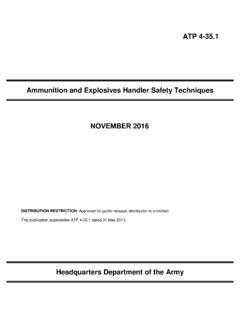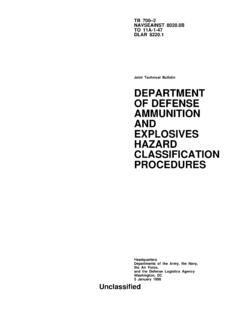Transcription of Process Safety Management for Explosives and Pyrotechnics ...
1 OSHA 3912-03 2017 Process Safety Management forExplosives and Pyrotechnics ManufacturingOccupational Safety and Health Act of 1970 To assure safe and healthful working conditions for working men and women; by authorizing enforcement of the standards developed under the Act; by assisting and encouraging the States in their efforts to assure safe and healthful working conditions; by providing for research, information, education, and training in the field of occupational Safety and health. This guidance document is not a standard or regulation, and it creates no new legal obligations. It contains recommendations as well as descriptions of mandatory Safety and health standards. The recommendations are advisory in nature, informational in content, and are intended to assist employers in providing a safe and healthful workplace. The Occupational Safety and Health Act requires employers to comply with Safety and health standards and regulations promulgated by OSHA or by a state with an OSHA approved state plan.
2 In addition, the Act s General Duty Clause, Section 5(a)(1), requires employers to provide their employees with a workplace free from recognized hazards likely to cause death or serious physical contained in this publication is in the public domain and may be reproduced, fully or partially, without permission. Source credit is requested but not information will be made available to sensory impaired individuals upon request. Voice phone: (202) 693 1999; teletypewriter (TTY) number: 1 877 889 5627. Process Safety Management for Explosives and Pyrotechnics Department of LaborOccupational Safety and Health AdministrationOSHA 3912 03 2017 ContentsPurpose ..1 Applicability ..5 Process Safety Information ..7 Information on Highly Hazardous Chemicals ..8 Information on Process Technology ..8 Information on the Process Equipment ..9 Process Hazard Analysis ..12 Operating Procedures ..13 Training.
3 15 Mechanical Integrity ..16 APPENDIX A: Related Publications ..19 APPENDIX B: Frequently Asked Questions ..21 Workers Rights ..22 OSHA Assistance, Services and Programs ..22 Establishing a Safety and Health Program ..22 Compliance Assistance Specialists ..22 Free On site Safety and Health Consultation Services for Small Business..22 Cooperative Programs ..23 Occupational Safety and Health Training Courses ..23 OSHA Educational Materials ..24 OSHA Regional Offices ..25 How to Contact OSHA ..27 Process Safety Management FOR Explosives AND Pyrotechnics MANUFACTURING1 Purpose This document does not cover the entire Process Safety Management (PSM) standard, but only focuses on aspects of the standard particularly relevant to Explosives and pyrotechnic manufacturers. OSHA s standard on Explosives and Blasting Agents, 29 CFR , provides a definition of Explosives and Pyrotechnics . For a full compliance guide to PSM, please refer to OSHA 31321 or the full text of the standard at Although all elements of the PSM standard apply to a PSM covered Explosives and Pyrotechnics manufacturer, the following elements of the standard are particularly relevant to hazards associated with Explosives and Pyrotechnics manufacturers: Process Safety Information (PSI) Process Hazards Analysis (PHA) Operating Procedures Training Mechanical Integrity (MI)PSM is critically important to facilities that manufacture Explosives and Pyrotechnics .
4 The required Safety programs will help prevent fires, explosions, and other major incidents. Compliance with the PSM standard will help ensure that employees, contractors, facility visitors, and emergency responders are safe from hazards. Compliance will also benefit employers by minimizing damage to facility equipment and neighboring structures. All Explosives should be handled with care. Explosives are chemicals compounds, mixtures or devices that will detonate or deflagrate when supplied with sufficient initiating energy. Furthermore, Explosives do not distinguish between initiating energy supplied accidentally or deliberately. Those who handle and use explosive materials in the manufacturing Process must prevent exposure of the material to accidental sources of initiating energy. 1. Safety AND HEALTH ADMINISTRATION2 The first two graphs shown below represent citations recorded as the result of OSHA PSM inspections conducted from 2000 to 2015 for Explosives Manufacturers under the North American Industry Classification System (NAICS) code 325920 and Pyrotechnics Manufacturing information extracted from NAICS code 325998.
5 The graphs illustrate the percentages of citations for specific PSM elements as they appear in the Department of Labor Enforcement database. Between 1992 and 2015, OSHA issued citations in 10 fatality cases (associated with a total of 19 fatalities). The following graph shows percentages of citations for specific PSM elements. The data, was taken from OSHA s IMIS (or OIS) of the graphs illustrates the similarity in percentages of the PSM elements cited as a result of OSHA inspections whether or not the inspections were performed as a result of a reported fatality. OSHA believes that this comparison implies that a better understanding Process Safety Management FOR Explosives AND Pyrotechnics MANUFACTURING3of the major elements of PSM, particularly those elements most frequently cited, would improve compliance and prevent fatalities in Explosives and Pyrotechnics manufacturing. PSM elements complement the cardinal principle for explosive Safety : expose the minimum number of people to the smallest quantity of Explosives for the shortest period consistent with the operation being conducted.
6 This principle is stated in many industry Explosives Safety standards and referenced in government publications such as: DoD Instruction ; NASA Standard ; AFMAN 91 2015; Army Pamphlet p385 64; and in commercially available Explosives Safety training. Successfully implementing this principle means establishing personnel limits and devising methods to reduce the number of people exposed, the time of exposure, and the quantity of material that could be involved in a single incident. Explosives and Pyrotechnics manufacturing is an inherently hazardous Process . Failure to properly recognize unsafe conditions and to take steps to mitigate the hazards can result in unexpected circumstances that can, and do, result in injury or death. Below are some examples of incidents that resulted from PSM non Fireworks Manufacturing (02/06/15): 2 FatalitiesAn explosion occurred at a fireworks manufacturing facility, which resulted in two fatalities.
7 The investigation identified several problems including housekeeping of hazardous materials (that were susceptible to friction heat and pressure), structural failure, and a failure to have code required separation distances between buildings. Inspectors also found that employees had no formal fireworks Safety training and no annual refresher Flares Company LLC (02/25/14): 1 FatalityOn February 22, 2014, an employee was working in a Mix Room. He was cleaning a residual composition that had adhered to surfaces of the mix bowl and mix wheel. As the employee removed the residual, the composition ignited and exploded. The investigation identified noncompliance in Process Safety information, Process hazard analysis and OCCUPATIONAL Safety AND HEALTH ADMINISTRATION4operating procedures. The employee suffered severe burns on multiple areas of his body and was transported to a hospital, where he received medical treatment and burn therapy, but died from his Mag (05/14/10): 2 FatalitiesOn May 14, 2010, an explosion occurred at a synthetic gunpowder manufacturing facility.
8 Instead of implementing existing engineering and administrative controls, two employees and the plant supervisor hand fed a gunpowder substitute (Black Mag powder) into operating equipment. Additionally, the employer did not implement remote starting procedures, safe distancing, isolated stations, and barriers or shielding for the Process of manufacturing explosive powder. The two employees died of injuries from the Corporation, Winchester Division (11/24/2008): 1 InjuryOn November 24, 2008, an employee at an Explosives manufacturing facility was sweeping up primers (small metal cups of explosive) into a dustpan. As the employee started to lift the dustpan, a few primers dropped and exploded upward. The employee s face, torso, shoulders, neck and head were injured, burned, and she was hospitalized. A safe job procedure was developed for the job but not for cleanup. The job involved a PSM covered Process , but no PHA was developed for the cleanup task.
9 American Ordnance LLC, Iowa Army ammunition Plant (6/12/2006): 2 FatalitiesOn June 12, 2006, two employees were handling a shaped charge of high Explosives on a cart. These employees were conducting a wet density test involving a shaped charge. During the test an explosion occurred, killing both employees. The investigation determined that violations of PSM requirements for Process hazard analysis, operating procedures, training, pre startup Safety review and performance of compliance audits contributed to the Safety Management FOR Explosives AND Pyrotechnics MANUFACTURING5 Sierra Chemical Co . (01/07/98): 4 FatalitiesOn January 7, 1998, four employees were about to begin work in the production room at Sierra Chemical s Kean Canyon Explosives manufacturing facility when two large blasts involving over 40,000 lbs. of Explosives devastated the facility. All four employees were killed. The facility melted, mixed, and poured cast boosters in two separate production areas using large heated stainless steel melting and mixing kettles.
10 The production room had been in service for less than four months and had several substantial changes compared to the old production area, including kettles heated by steam as opposed to hot water and direct drive mechanical agitation instead of hydraulic agitation. Possible causes of the explosions included raw material contamination, a cold start, or static ignition. The investigation resulted in citations for violations of the Employee Participation, Process Safety Information, Process Hazard Analysis, Operating Procedures, Training, Pre startup Safety Review, Mechanical Integrity, and Management of Change provisions of the PSM Employers who manufacture explosives3 and Pyrotechnics 4 must comply with PSM (see 29 CFR (k)). OSHA considers the manufacturing of Explosives to mean: mixing, blending, extruding, synthesizing, assembling, disassembling and other activities involved in the making of 3. The term explosive is defined in 29 CFR , Explosives and Blasting Agents, paragraph (a)(3):Explosive any chemical compound, mixture, or device, the primary or common purpose of which is to function by explosion, , with substantially instantaneous release of gas and heat, unless such compound, mixture, or device is otherwise specifically classified by the Department of Transportation; see 49 CFR Chapter I.

















